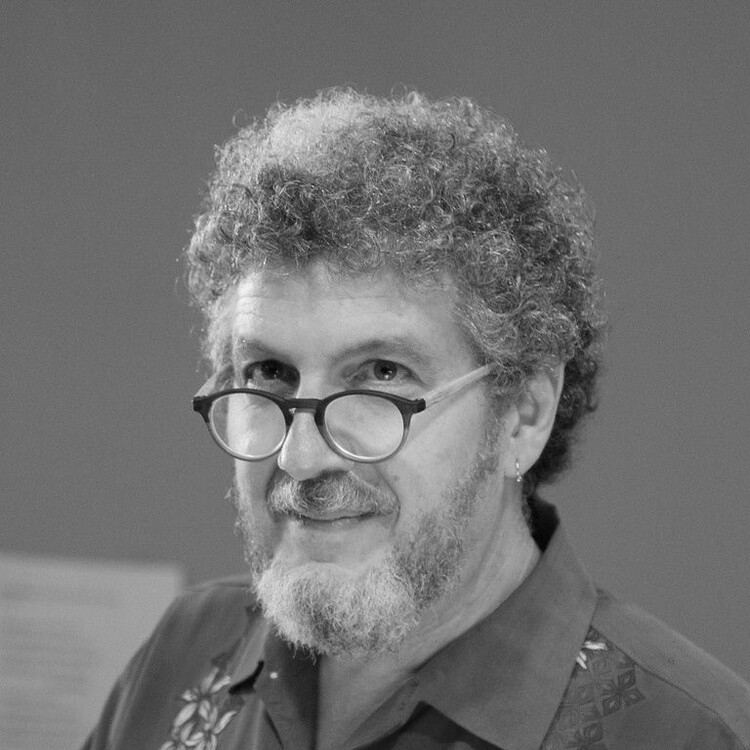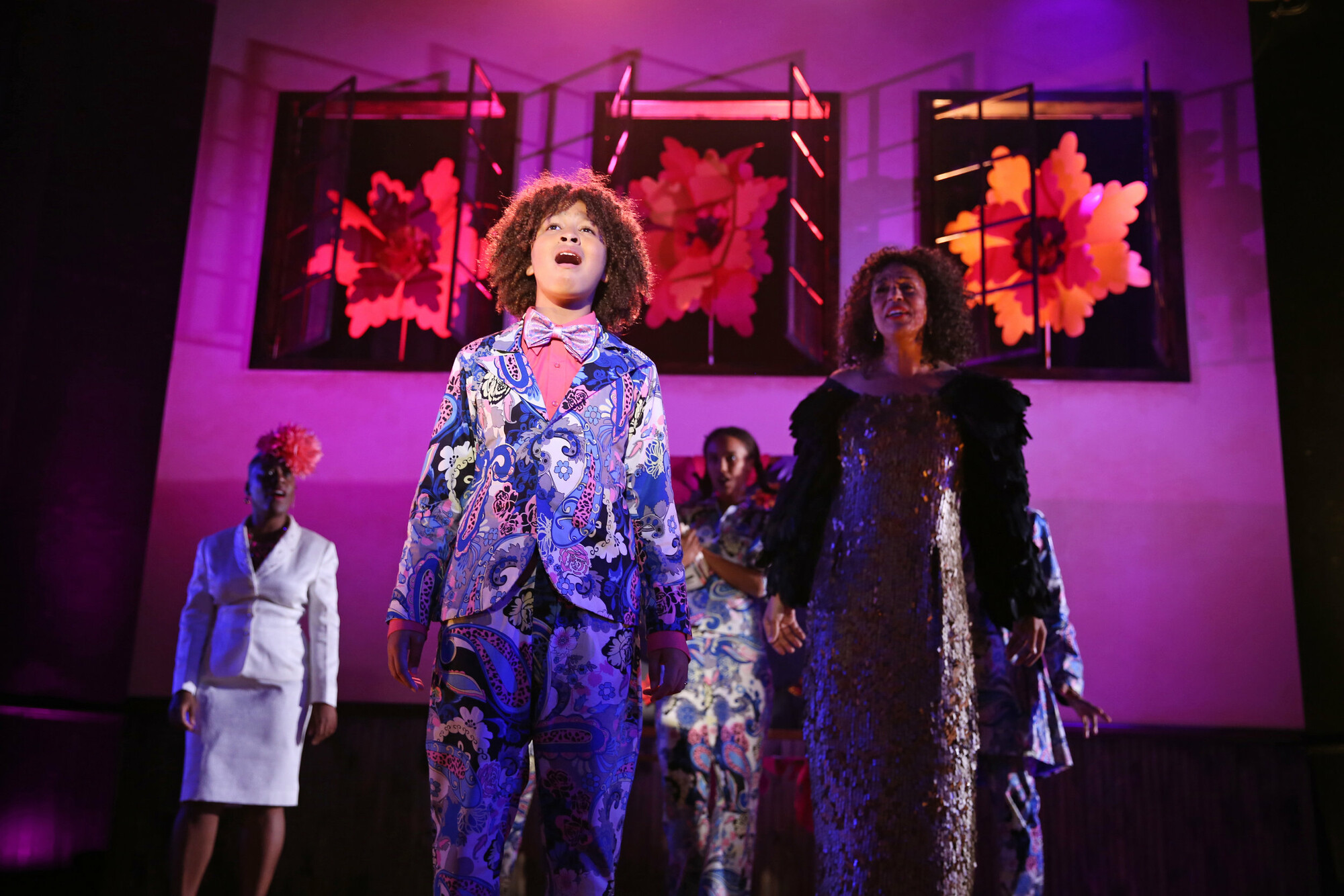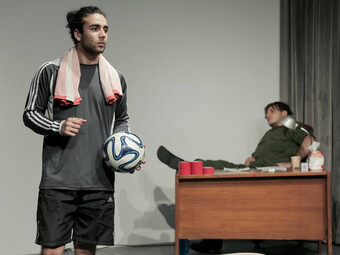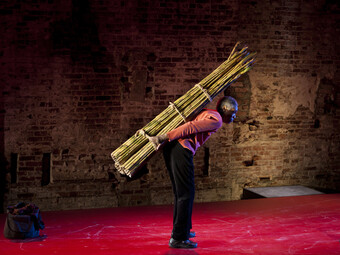“What if I told you it's going to be all right? What if I told you, not yet? What if I told you that we won't all make it through?” This is the challenge that hangs in the air, even in the show’s most dazzling, musical moments: Who or what are we willing to sacrifice to free ourselves, separately and together, from the hate of others?
Daniel has grown a mature body of work from questions, unique practice, and an ever-present artistic ancestry. He holds opposing energies in artistic suspension—darkness and illumination, violence and love, skepticism and hope. Jomama brings her conjurer balance, too, a counterweight for his tender heart. With her gimlet eye and wry majesty, Jo keeps her cousin’s edge sharp. Together they are fearless. However hateful the enemy, the Joneses maintain communal celebration as the center of their offering. With them we celebrate the fullness of human capacity. We celebrate the theatre as a way of enlarging ourselves, increasing our empathy—thinking with the body, feeling with the spirit, singing with the mind. “There is no work harder than expanding what can be…” Jomama sang in an earlier show. We sing the body electric, eclectic, expressive, and expansive.
Daniel…holds opposing energies in artistic suspension—darkness and illumination, violence and love, skepticism and hope.
Daniel is often pegged as a solo performer, but he is no more a solo performer than Taylor Mac, the artist I think of as his fellow traveler and peer in reshaping theatre culture through monologue and song. Both perform solo acts with a full complement of distinctive collaborators—musicians, singers, designers, composers, and directors. Daniel has his band; Taylor, his minions. Both flower in the most bio-diverse gardens. I once heard Daniel, in a solo performance workshop, tell students that the first principle of solo work is that it is never solo; it is always created with others. And he proves it. Even the audience—which he uniquely forges into a community at each performance—is part of that creation.
Against the national myth that hails the “self-made,” Daniel lifts up a powerful countermyth: selfhood is collectively made, shaped by the community of others. We can watch this communitarian evolution of Daniel himself—or the characters who stand in for him—over the course of his writing career. The Book of Daniel, which he calls “a feast of fears,” an early solo work devised in intense collaboration with numerous others, takes on this idea directly.
Against the national myth that hails the “self-made,” Daniel lifts up a powerful countermyth: selfhood is collectively made, shaped by the community of others.
As a child the incipient artist observes, soaking in the songs around him. A house named José narrates the protagonist Daniel’s story, translated by a black cat:
See here? His love affair with art begins when he is a child. See here? In the undressed rooms of the bird mother and the lion father. In this small yellow house on the short street. There he is, silver brown eyes and giggles. The bird mother plays records and dances with the lion father. Miriam Makeba. Odetta. José Feliciano, after whom they christen me (this house) José. Daniel watches the music tie his parents together. Daniel hears this house creak side to side in time.
The Book of Daniel begins a song cycle that in some ways continues through today. In it we meet the first of a line of instigating ancestors—Makeba, Odetta, Feliciano. This line, too, keeps unspooling.
In a later play, Bel Canto, the boy is now called Benjamin. He is stopped on the street by a woman named Scarlatti, who will become his mentor. She teaches him to sing and introduces him to Opera. She then leads him to Marian Anderson, the first of many divas, singers who, as his personal angels, will make him the artist he will one day become.
It is 1939, and the great African American contralto, having been denied an indoor hall for her concert, makes an extraordinary appearance on the steps of the Lincoln Memorial.
BARBARA
There were thousands of us, Benjamin.
Endless cluster of faces and hands
leaning toward those high marble steps
Awkward together in this
sudden wonderment
on Easter Sunday[…]
As Barbara Scarlatti tells her story, the stage as Daniel describes it, silently and magically fractures and reforms into “a modified Flag with vertical stripes and a horizontal bar of blue and stars.”
BARBARA
Her entrance, you see, was the shock of
pure radiance
She walked down the steps
to the wide bank of microphones
Her face… I can see it as though…
You see, light streamed forth from her face…
She opened her mouth…
And the wave of sound,
the rolling luminous wave
Oh! we barely breathed
[…] we all stood in her presence…
bowed
transfixed
lifted
our hot tears stung our cheeks
for, on that day, that woman, Benjamin, that great lady from
Philadelphia, belonged to something far greater than anything
we could rightly name…
Barbara guides the boy into the heart of music and towards that something “far greater.” She also shepherds him into a complex, disturbing narrative of race. She was on those Memorial steps as a girl. She broke away from her mother and met the eyes of the magnificent singer. The child Barbara then heard a familiar voice among the musicians, packing their instruments and recapping the day.
And there among them
As plain as day
was my father.
Without even thinking,
I cried out
Papa! Papa!
I bounded further up the tall steps,
he turned his face toward me
and a look of clear terror flashed across it.
I tripped and fell,
rolling back and down,
tearing my stockings,
bloodying my hands, my knees,
cutting my lip.
I stood shakily and turned back to find him.
He looked down
for an incredible instant
this child saw through him…Benjamin…
The way you can see through me right now…
My father. (All that time)
He was afraid that people would
discover that he in fact was a colored man.
My father
then quickly turned his face
and receded into the Memorial
with the other musicians.
The stripes and bars re-form. We are in the landscape of music, of art, of America, of race—which is the central story of our nation. And that other story, too, when Benjamin throws himself into a fight in the high school shower, where another boy is getting beaten for being gay. Barbara Scarlatti offers the boy a thread that will lead him, not out of the maze, but into it. Daniel Alexander Jones does this, too. He extends a hand to us, singing, “Open, open wider. Feel more deeply./Transform, transform, transform.” And he ushers us into the shadow maze of America.











Comments
The article is just the start of the conversation—we want to know what you think about this subject, too! HowlRound is a space for knowledge-sharing, and we welcome spirited, thoughtful, and on-topic dialogue. Find our full comments policy here